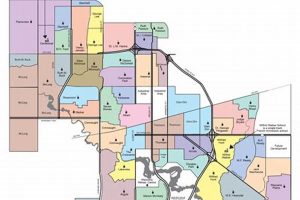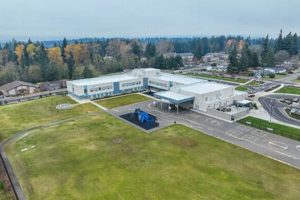Blended learning environments for young pupils combine traditional classroom instruction with online learning components. Students experience a mix of in-person learning with teachers and classmates and independent study utilizing digital resources. For instance, a class might attend school two days a week for face-to-face lessons and complete online assignments and activities the remaining days.
This educational model offers potential advantages such as personalized learning experiences tailored to individual student needs and pacing, increased flexibility for families balancing work and education, and development of digital literacy skills essential for the modern world. The emergence and refinement of these programs have been spurred by advancements in educational technology and evolving societal needs, including increased demand for flexible schooling options. The recent rise in remote learning further accelerated the adoption of these combined approaches.
This article will further explore the various models employed, the benefits and challenges associated with this approach, and the impact on student outcomes. Key topics to be examined include curriculum design in blended settings, effective teacher training strategies, and the role of technology in facilitating a successful learning experience.
Successful implementation of combined traditional and online learning environments requires careful planning and execution. These tips provide guidance for families and educators seeking to maximize the effectiveness of this educational approach.
Tip 1: Establish Clear Communication Channels: Open and consistent communication between teachers, parents, and students is crucial. Regular updates, clear expectations, and readily available contact information facilitate a supportive learning environment.
Tip 2: Create a Dedicated Learning Space: A designated area free from distractions promotes focus and productivity during online learning sessions. This space should be equipped with necessary technology and resources.
Tip 3: Foster a Structured Routine: Maintaining a consistent schedule helps children adapt to the blended learning format. Designated times for online learning, breaks, and offline activities provide structure and predictability.
Tip 4: Encourage Active Learning: Incorporate interactive activities, projects, and discussions to keep students engaged and promote deeper understanding. Hands-on experiences can bridge the gap between online and offline learning.
Tip 5: Prioritize Digital Literacy Skills: Equipping students with the skills to navigate online platforms, utilize digital tools, and practice online safety is essential for success in blended learning environments.
Tip 6: Monitor Progress and Provide Feedback: Regular assessment and timely feedback help track student understanding and identify areas requiring additional support. Personalized feedback encourages continued growth.
Tip 7: Cultivate a Supportive Community: Building connections between students, teachers, and families fosters a sense of belonging and shared responsibility. Online forums, virtual meetings, and in-person events can help create a supportive community.
By implementing these strategies, educators and families can create a positive and productive blended learning experience that fosters academic success and prepares students for the future of learning.
These insights offer practical guidance for navigating the evolving landscape of elementary education. Further exploration of these topics will be presented in the concluding sections of this article.
1. Blended Learning Models
Blended learning models form the core structure of hybrid elementary schools. These models dictate how online and in-person learning are combined to create a comprehensive educational experience. The chosen model significantly impacts the efficacy of a hybrid program. For example, the Rotation model, where students rotate between online and offline stations within the school, differs substantially from the Flex model, where students primarily learn online with teachers providing personalized support as needed. The selection of a model depends on factors such as student needs, available resources, and educational goals. Effective implementation relies on aligning the chosen model with the school’s infrastructure and curriculum.
A practical example is a school implementing the Enriched Virtual model. Students primarily learn online at home, supplementing their studies with occasional in-person enrichment activities or support sessions at school. This contrasts with the Station Rotation model, where students rotate through different stations within the classroom, including online learning stations. Understanding the nuances of each model enables educators to create targeted learning pathways that optimize the benefits of both online and offline instruction. The successful implementation of these models requires careful consideration of curriculum alignment, technological infrastructure, and teacher training.
Careful selection and implementation of a blended learning model is essential for successful hybrid elementary schools. Challenges include ensuring equitable access to technology, providing adequate teacher training, and maintaining consistent communication between teachers, students, and parents. Addressing these challenges requires a comprehensive approach that considers pedagogical best practices, community engagement, and ongoing evaluation to ensure that the chosen model effectively serves the needs of all students and facilitates a positive learning experience.
2. Curriculum Adaptation
Curriculum adaptation is essential for the success of hybrid elementary schools. The integration of online learning necessitates modifications to traditional curricula to ensure effective delivery and student engagement. Simply transferring existing lesson plans to a digital platform often proves inadequate. Curriculum adaptation involves restructuring content, incorporating interactive digital resources, and designing activities that leverage the strengths of both online and offline learning environments. For example, a science lesson on the water cycle might include an online simulation demonstrating evaporation and condensation, followed by a hands-on experiment in the classroom exploring precipitation. This blended approach caters to diverse learning styles and promotes deeper understanding.
Effective curriculum adaptation considers the unique characteristics of online learning, such as the need for self-paced activities, opportunities for collaboration, and regular feedback mechanisms. Furthermore, it addresses the challenges of maintaining student engagement and ensuring equitable access to resources. A mathematics curriculum might incorporate online tutorials and practice exercises tailored to individual student needs, followed by in-person problem-solving sessions in small groups. This personalized approach allows students to progress at their own pace while fostering collaborative learning. The adaptation process also requires ongoing evaluation and refinement based on student performance and feedback. A social studies unit might initially involve online research followed by classroom discussions, but adjustments might be needed based on student engagement and comprehension levels. Flexibility and responsiveness are key components of successful curriculum adaptation in hybrid settings.
Successfully adapting curricula for hybrid elementary schools requires a deep understanding of pedagogical best practices, technological affordances, and student learning needs. It presents challenges, including the need for professional development for teachers, access to appropriate digital resources, and ongoing assessment strategies. However, effective curriculum adaptation is crucial for ensuring that hybrid learning models provide a rich and engaging educational experience that prepares students for the demands of the 21st century. The ultimate goal is to create a seamless blend of online and offline learning experiences that maximizes student learning outcomes and fosters a love of learning.
3. Teacher Training
Effective teacher training is paramount for the success of hybrid elementary schools. Educators require specific skills and knowledge to navigate the complexities of blended learning environments. This training must go beyond basic technical proficiency and encompass pedagogical approaches tailored to hybrid instruction. It plays a crucial role in ensuring that teachers can effectively utilize technology, adapt curricula, and support diverse student learning needs within these dynamic educational settings.
- Pedagogical Approaches for Blended Learning
Teachers need training in pedagogical approaches specific to blended learning. This includes designing engaging online activities, facilitating effective online discussions, and blending synchronous and asynchronous learning experiences. For example, teachers must learn how to use online platforms for collaborative projects, provide individualized feedback through digital tools, and structure lessons that seamlessly transition between online and offline components. This ensures that both learning environments are effectively utilized to maximize student learning.
- Technology Integration and Digital Literacy
Beyond basic computer skills, teachers require training on effectively integrating technology into the curriculum. This includes selecting appropriate digital tools and resources, utilizing learning management systems, and troubleshooting common technical issues. For instance, teachers must become proficient in using interactive whiteboards, educational software, and assessment platforms. Developing their digital literacy enables them to create engaging and effective learning experiences that leverage the full potential of technology.
- Differentiated Instruction in Hybrid Environments
Meeting the diverse needs of learners in a hybrid setting presents unique challenges. Teacher training should address strategies for differentiating instruction across both online and offline platforms. This includes using technology to personalize learning pathways, providing targeted interventions, and offering flexible pacing options. For example, teachers can use online platforms to deliver differentiated content, provide individualized feedback, and track student progress. This enables them to tailor instruction to meet the unique needs of each learner, regardless of their learning style or pace.
- Assessment and Data Analysis in Blended Learning
Assessing student learning in a hybrid model requires utilizing both traditional and digital assessment methods. Teachers need training on designing and implementing effective online assessments, interpreting data from learning analytics, and using data to inform instruction. For example, teachers can utilize online quizzes, formative assessments, and data from learning platforms to track student progress and identify areas where students may need additional support. This data-driven approach allows teachers to adjust their instruction and provide targeted interventions to ensure that all students are succeeding.
These facets of teacher training are interconnected and essential for creating a thriving hybrid learning environment. Well-trained teachers can effectively leverage technology, adapt curricula, and create engaging learning experiences that cater to the diverse needs of all students. This comprehensive approach to teacher training ensures that hybrid elementary schools are well-equipped to provide high-quality education that prepares students for the future.
4. Technology Integration
Technology integration is not merely an addition but a fundamental component of successful hybrid elementary school models. It provides the infrastructure and tools necessary to bridge the gap between in-person and online learning, facilitating a cohesive and engaging educational experience. Effective technology integration requires careful consideration of pedagogical approaches, digital literacy development, access and equity, and ongoing evaluation.
- Learning Management Systems (LMS)
LMS platforms serve as a central hub for organizing and delivering online learning materials, assignments, and assessments. They provide a structured environment for students to access resources, submit work, and receive feedback. A robust LMS allows teachers to track student progress, differentiate instruction, and communicate effectively with students and parents. In a hybrid model, the LMS becomes the connecting thread between in-person and online learning, ensuring continuity and consistency.
- Interactive Learning Resources
Digital learning resources, such as educational games, simulations, and interactive videos, enhance engagement and cater to diverse learning styles. These tools provide opportunities for students to explore concepts in dynamic ways, fostering deeper understanding. For instance, a virtual field trip can supplement a geography lesson, while interactive math games can reinforce numeracy skills. In a hybrid model, these resources can be used both in the classroom and at home, creating a seamless learning experience.
- Communication and Collaboration Tools
Effective communication and collaboration are crucial in hybrid learning environments. Video conferencing platforms facilitate real-time interaction between teachers and students, while online forums and collaborative document editing tools enable asynchronous communication and project-based learning. These tools foster a sense of community and connection, even when students are learning remotely. Consistent communication between teachers, students, and parents is key to ensuring that everyone stays informed and connected.
- Assistive Technologies
Assistive technologies play a vital role in ensuring equitable access to learning for students with diverse needs. These tools can range from text-to-speech software and screen readers to adaptive keyboards and specialized learning apps. Integrating assistive technologies into the hybrid model ensures that all students have the opportunity to succeed, regardless of their individual learning differences. Careful consideration of accessibility features is essential for creating an inclusive learning environment.
The seamless integration of these technologies is fundamental to realizing the full potential of hybrid elementary schools. It empowers educators to create dynamic, engaging, and personalized learning experiences that cater to the diverse needs of all students. Ongoing evaluation and professional development are essential to ensure that technology is used effectively to enhance teaching and learning in this evolving educational landscape. By strategically leveraging technology, hybrid models can create a more equitable, accessible, and engaging learning experience for all elementary students.
5. Parental Involvement
Parental involvement takes on a multifaceted and crucial role in hybrid elementary school settings. The blended learning environment necessitates a deeper collaboration between parents and educators than traditional models. This increased involvement stems from the unique demands of balancing in-person and online learning. Parents become active participants in facilitating their child’s learning journey, providing support with technology, ensuring a conducive learning environment at home, and maintaining consistent communication with teachers. For example, a parent might help their child log into online platforms, troubleshoot technical issues, and ensure they complete online assignments as scheduled. This direct involvement bridges the gap between the classroom and the home, ensuring a cohesive learning experience.
The impact of robust parental involvement extends beyond logistical support. Parents play a vital role in fostering a positive learning environment at home, reinforcing classroom learning, and supporting their child’s social-emotional well-being during this potentially challenging transition. Creating a dedicated workspace free from distractions, establishing consistent routines, and engaging in open communication about their child’s learning progress contribute significantly to their academic success. For instance, a parent might set up a designated learning area with necessary supplies, establish a daily schedule for online and offline activities, and regularly communicate with the teacher about their child’s progress and any challenges they are facing. This proactive approach reinforces the importance of education and creates a supportive learning environment at home, which is particularly important in the hybrid model where students spend a significant amount of time learning independently.
Successful hybrid elementary schools recognize the integral role of parents and actively foster partnerships through regular communication channels, workshops, and online resources designed to empower parents with the skills and knowledge to support their child’s blended learning experience. Addressing challenges such as digital literacy gaps, varying levels of parental availability, and access to technology requires a collaborative approach between schools and families. Providing resources like online tutorials for parents on using the learning management system, flexible communication options, and technical support can bridge these gaps and ensure equitable access to a quality education for all students. Ultimately, fostering a strong home-school connection is paramount for creating a thriving hybrid learning environment that effectively supports student success and well-being.
6. Student Engagement
Student engagement forms a cornerstone of successful hybrid elementary school models. Maintaining high levels of engagement presents unique challenges in blended learning environments, where students navigate both in-person and online learning modalities. A decline in engagement can lead to decreased motivation, reduced academic performance, and a sense of disconnect from the learning community. Therefore, fostering active participation and a sense of ownership over the learning process becomes paramount. Strategies that promote engagement in traditional classrooms, such as hands-on activities and collaborative projects, require adaptation for the online environment. For instance, an interactive science simulation can replace a physical experiment, while online discussion forums can facilitate collaborative learning outside the classroom. A teacher might use online polling tools during virtual lessons to gauge student understanding and encourage real-time interaction, or incorporate gamified elements into online assignments to enhance motivation and participation. The efficacy of these strategies relies on careful integration with the curriculum and alignment with the chosen blended learning model.
Addressing the specific challenges of student engagement in hybrid models requires a multi-pronged approach. This includes fostering a sense of community through virtual and in-person interactions, providing regular and personalized feedback, offering flexible learning pathways that cater to individual learning styles, and ensuring equitable access to technology and resources. For example, a teacher could organize virtual study groups or online social events to foster connections between students, provide individualized feedback through online platforms and during in-person check-ins, offer choices in assignments to accommodate different learning preferences, and ensure that all students have access to reliable internet and necessary devices. Schools might also provide training for parents on supporting student engagement at home, such as establishing dedicated learning spaces and helping children manage their time effectively. The goal is to create a supportive and stimulating learning environment that fosters active participation, encourages self-directed learning, and cultivates a sense of belonging for all students, regardless of their physical location.
Sustaining student engagement within hybrid elementary schools requires ongoing evaluation and adaptation. Regularly assessing student engagement levels through surveys, observation, and analysis of online participation data provides valuable insights into the effectiveness of implemented strategies. This data-driven approach allows educators to identify areas for improvement, adjust instructional practices, and personalize learning experiences to maximize student motivation and academic outcomes. Addressing the challenges of student engagement in hybrid models requires a commitment to continuous improvement, collaboration between teachers, parents, and students, and a focus on creating a learning environment that fosters active participation, intellectual curiosity, and a love of learning.
Frequently Asked Questions about Hybrid Elementary Schools
This section addresses common questions and concerns regarding blended learning environments in elementary education. The responses aim to provide clear and concise information to aid understanding and decision-making.
Question 1: How does a hybrid model differ from homeschooling or fully online school?
Hybrid models integrate both in-person classroom instruction and online learning components, unlike homeschooling or fully online school, which primarily occur in the home environment. The balance between in-person and online learning varies depending on the specific hybrid model implemented.
Question 2: What are the primary benefits of a hybrid elementary school program?
Potential benefits include personalized learning experiences, increased scheduling flexibility, development of digital literacy skills, and the ability to cater to diverse learning styles. These programs aim to combine the strengths of both traditional and online learning modalities.
Question 3: What are the potential challenges of hybrid learning for elementary-aged students?
Challenges may include ensuring equitable access to technology and reliable internet, maintaining consistent student engagement, addressing potential social-emotional learning gaps, and providing adequate support for both students and parents navigating the blended learning environment.
Question 4: What is the role of the parent or guardian in a hybrid learning model?
Parental involvement is crucial in hybrid models. Parents play a significant role in supporting their child’s online learning, ensuring a productive learning environment at home, facilitating communication with teachers, and reinforcing concepts learned in the classroom. Active parental engagement is essential for student success.
Question 5: How does a hybrid elementary school address the social-emotional needs of students?
Hybrid models often incorporate strategies to address social-emotional learning, such as incorporating planned social interaction time during in-person sessions, utilizing online communication tools to facilitate interaction, and implementing curriculum that focuses on social-emotional development. Maintaining connections between students and teachers remains a priority.
Question 6: How can parents determine if a hybrid elementary school is the right fit for their child?
Consider the child’s learning style, personality, and technology access. Research different hybrid models and programs, visiting potential schools, and speaking with administrators, teachers, and other parents are crucial steps. A thorough assessment of the child’s needs and the program’s offerings are necessary to make an informed decision.
Understanding the key components of hybrid elementary schools enables informed decision-making. Further research and consultation with educational professionals are encouraged. The following sections will delve deeper into specific aspects of hybrid models and their implementation.
Continue reading to explore further details about curriculum implementation in hybrid elementary schools.
Hybrid Elementary Schools
Blended learning programs represent a significant shift in elementary education. This exploration has highlighted key aspects of these programs, from the various blended learning models and their implementation to the crucial roles of curriculum adaptation, teacher training, technology integration, parental involvement, and student engagement. Effective implementation requires careful planning, ongoing evaluation, and a commitment to fostering a supportive and engaging learning environment for all students. Addressing the unique challenges of blended learning, such as ensuring equitable access to technology and maintaining student engagement, is essential for maximizing the potential of these innovative educational approaches.
The future of elementary education may well be defined by the continued evolution and refinement of blended learning models. As technology continues to advance and societal needs evolve, the flexibility and adaptability offered by these programs hold significant promise. Further research and ongoing dialogue within the educational community are crucial for shaping best practices and ensuring that these models effectively serve the diverse needs of all learners, preparing them for the challenges and opportunities of the 21st century. The successful integration of blended learning has the potential to transform elementary education, creating a more dynamic, personalized, and engaging learning experience for future generations.







